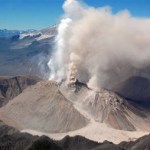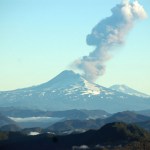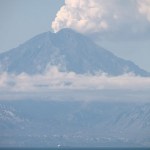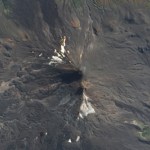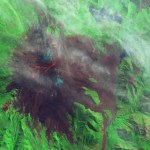Llaima
The rhyolite domes of Chaiten in Chile in an undated photo. Note how much of the previous Chaiten Caldera has already been filled by the new domes that started after Chaiten erupted in May 2008.
CNN International has a report that the National Emergency Office (ONEMI) in Chile has reinforced the "red alert" status of Chaiten (spanish). The volcano, which has been erupting since May 2008, had recently settled down to slow, but constant, dome growth. However, over the last 3 weeks, seismicity has been increasing at the rhyolite caldera, suggesting that we might be heading towards an upswing of…
Here it is, my attempt to recap a year's worth of volcanic events. By no means is this supposed to capture every event, but rather the highlight/lowlights and what most captivated me during 2009. I'll be announcing the winner of the 2009 Pliny for Volcanic Event of the Year tomorrow.
Waimangu Geothermal Valley in New Zealand, taken in January 2009 by Erik Klemetti.
January
The year started out with a trip to New Zealand (well, for me at least) and vistas of the Waimangu Valley, formed in the 1886 eruption of Tarawera on the North Island. We were also still thinking about the late 2008…
A new Weekly Volcano Report from the Smithsonian GVP/USGS ... enjoy!
Highlights include:
There has been a number of reports of new activity at Llaima in Chile (hat tip to Eruptions reader Manuel Humeres for bringing them to us). Most of the current activity is steam-and-gas plumes along with long-period seismicity, suggesting we could be headed towards a new eruption.
Lava flows continue to erupt from Kliuchevskoi in Kamchatka, along with strombolian activity throwing ejecta up to 300 m / ~1000 feet above the crater.
Rabaul is busy shaking windows 20 km / 12 miles from the Tavurvur crater,…
Busy busy analysing on the multicollector ICP-MS today (but not busy enough to miss this).
Here's your weekly volcano news roundup from the USGS/Smithsonian GVP.
Highlights (not including Sarychev Peak) include:
Continued dome growth and degassing at Bezymianny in Russia. Starting next year, there will be live webcams for three of the major volcanoes (Bezymianny, Kliuchevskoi, and Shiveluch) on the Kamchatka peninsula! Now, that is exciting news.
The glowing coming from the vent in the Halema'uma'u Crater at Kilauea in Hawai'i is still prominent. The lava levels in the crater have been…
I'm buried knee-deep in lab work this week, so I don't know how much internet scouring I will be able to do for new news, however, I should have time for a mailbag column.
So, do you have a burning (no pun intended) volcano question you want answered? Email the question(s) to me and I will try to answer them in a mailbag column later this week.
Send the questions to:
(And while you're at it, if you have any volcano images you'd like to share, send them to the same email address!)
Volcan Llaima in Chile erupting in February 2008. Image courtesy of Eruptions reader Melissa Lowman.
We've already talked about how many active volcanoes reside in Indonesia, but this week's USGS/SI update just drives that point home. Listed in the update are no less than 5 volcanoes were activity is being seen or is on the increase (Karangetang, Slamet, Dukono, Batu Tara and Makian). This doesn't mean mention the activity at Anak Krakatau, Rinjani or Semeru. Amazing.
Anyway, highlights - not counting Indonesia or the South American trio - from this week's report (as usual aptly put together by Sally Kuhn Sennert) include:
A ~8,000 foot / 2.4 km ash and steam plume from Bagana in Papua New…
Redoubt emitting a large steam plume in April 2009. Image courtesy of Calvin Hall.
A few snippets from the world of volcanoes:
The current eruptive cycle at Galeras continues to go strong. Officials with INGEOMINAS, the Colombian Geology Survey, believe the volcano will erupt again in the next few "days to weeks". The volcano last erupted a few weeks ago (in spanish) and caused quite a bit of panic in the city of Pasto at the foot of the volcano. An Orange Alert has been issued (in spanish) for the volcano.
Another volcano have is on the verge of a larger eruption is Nyiragongo in the DR of…
It has been rather quiet on the volcano-front in the last week. Redoubt and Llaima (in spanish), after a few weeks of intense eruption, are both back on Orange Alert. News of the eruptions from Hunga Tonga Hunga Ha'apai and Fernandina is rather sparse in the details. The news of volcanism in 2009 seems to have settled down.
A few tidbits I caught over the weekend:
Chaiten
Damage wrought by the eruption of Chaiten on the town of Chaiten in Chile, taken in early December 2008. Image courtesy of the NASA Earth Observatory.
Don't you feel like you're read this sort of story before after other…
The weekend is rolling in and I might end up spending most of it in the 90+ degree California weather, so unless something big comes up (volcanically), I'll leave you with a few news bits.
Llaima
Llaima in April 2009. Image courtesy of the NASA Earth Observatory
This is a true color image of Llaima in Chile, provided by the great folks at the NASA Earth Observatory. You can clearly see the dark grey new tephra on the main summit cone along with the grey ash covering the snow on the southwestern part of the volcano (north is up). A few other fun features are some smaller parasitic cones in…
Just a quick note before I'm off to this ...
Llaima
The SERNAGEOMIN is evaluating whether the alert level at Llaima should be lowered to Yellow in the near future (in spanish). Seismic acitivity at the volcano have come down since the eruptions started a few weeks ago and most of the activity now seems to be fumarolic in nature.
Popocatépetl
Popo (as it is also called) continues to produce steam/gas plumes (in spanish), 5 in one day on Monday of this week. However, all the other usual volcanic monitoring parameters (seismicity and the like) are unchanged according to Cenapred (National…
Fernandina, Ecuador
Fernandina erupting in 2009.
UPDATE 4/13/09 at 12PM: The NASA Earth Observatory has posted a nice MODIS image showing the plume from the Fernandina eruption drifting out over the Pacific.
We have a few more details on the ongoing eruption at Fernandina in the Galapagos Islands. Officials from the Parque Nacional Galápagos (PNG) flew over the island (in spanish) and saw the eruption is coming from a several-kilometer-long fissure vent that flows towards the sea, dividing into multiple flows and then coalescing when it reaches the sea. There is also a lot of vapor being…
Llaima in Chile, taken on April 9, 2009. Image courtesy of the NASA Earth Observatory.
The NASA Earth Observatory (currently celebrating its 10th year) has posted a number of great images of the current eruption of Llaima in Chile, taken from Earth Observing-1 and Terra Satellites. They show both the ash plume of the eruption and the lava flows associated with it (above). The image here is a false-color image of Llaima, where the bright red/orange is the lava flow from the volcano, along with the dark brown of the ash/rocks from this and previous eruptions.
The eruption itself might continue…
Llaima in Chile erupting in 2009.
A quick note to pass along about the ongoing eruption at Llaima in Chile. The eruption did seem to be waning earlier in the week, but the news now is that debris from the eruption is partially blocking the vent. The cone of pyroclastic material (tephra) that has been ejected during the eruption is now overlapping the main crater, potentially blocking part of the vent ... and most people know what happens if you plug up a volcano that is actively erupting - blammo!
The SERNAGEOMIN is not certain that this cone of material (in spanish) will cause a more…
Llaima erupting at night in April 2009.
Brief update for those of you following the somewhat spectacular eruption (above and below) going on at Llaima in Chile. The latest reports indicate the eruption is waning (in spanish) with less ash and explosions (in spanish) being produced. However, ONEMI, the Chilean Emergency Office, continues to keep the area on alert. So far, at least 81 people have been evacuated (in spanish) during the eruptions that gained strength over the weekend and flights between Buenos Aires and Neuquén were suspended due to the ash.
It is interesting to note the…
Llaima erupting in April 2009.
Just a quick note about the eruption currently ongoing at Llaima in Chile. The volcano continues to explosively (and effusively) erupt, sending ash ~22,000 feet / 7,000 meters into the air. This eruption has produced 37 hours of intense eruption (in spanish) so far and the ash from the eruption is drifting into Argentina, almost 100 km to the SE of the volcano. More evacuations are being called for by ONEMI and so far 71 people have left the vicinity of the volcano due to fears of lahars and significant ash fall (In spanish, but it does provide video of the…
Today looks to be a doubleheader of volcano news:
Redoubt
Image courtesy of AVO/USGS, taken by Rick Wessels. An infrared image of the north slope of Redoubt showing the hot, new dome material and hot block & ash flows confined to the valley.
At 11:30 AM yesterday, AVO put Redoubt back to Orange/Watch alert status after the volcano seem to settle down to small steam/ash plumes. Less than 12 hours later (at ~6:30 AM Alaska time), the volcano produced another large explosive eruption, sending an ash column up ~50,000 feet / 15 km and producing what seems to be a significant lahar that…
There haven't been any major developments volcano-wise over the weekend, just a few updates on some current rumblings:
Â
Soufriere Hills (Montserrat) coughed up more ash, producing ash columns to "thousands of feet" according to reports from the MVO. The eruptions/explosions were centered at the lava dome on the summit of the volcano, Seismicity has also increased, suggesting that a larger eruption might be in the works.
Chaiten continues to worry Chilean geologists. Although the eruption seems to have reduced in intensity over the weekend, the fear of a blockage that…
The latest eruption at Llaima is beginning to slow down according to Chilean state geologist, Hugo Moreno. The volcano has been erupting for most of the month, forcing limited evacuations. The eruption has (so far) produced lava flows, ash falls and some bombs thrown from the crater. However, the SERNAGEOMIN is keeping the "red alert" on Llaima.
With persistently active volcanoes like Llaima, it is not surprising that they see multiple eruptive periods during each year. In a sense, this is actually better for the people living around the volcano because the more often the volcano erupts, the…
Llaima (Chile) is experiencing an increased tempo in its current eruption. The National Emergency Office in Chile is reporting that the eruption has begun to take a more explosive character, with pyroclastic material being shot hundreds of meters from the main vent. Although the officials have not changed the current status of the evacuation, which has been limited to 50 people closest to the volcano, they are pondering their next step if the week-old eruption continues to escalate.
[wp_caption id="" align="alignnone" width="360" caption="Llaima 2008"][/wp_caption]
The current eruption at Llaima in Chile is causing some concern about flooding in the Rio Calbuco near the volcano. The lava flows are melting snow on the volcano and this is being exacerbated by heavy rain in the area as well. The eruption seems to have waned some according to the governor of the region. This all follows the evacuations of people near the volcano and the red alert issued by the Chilean government. (The picture of Llaima is from the January 2008 eruption.)
